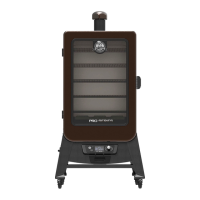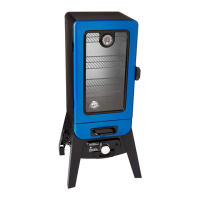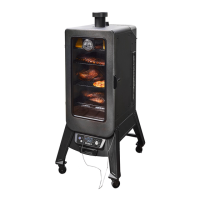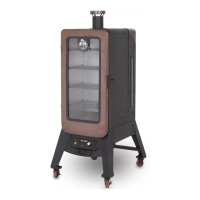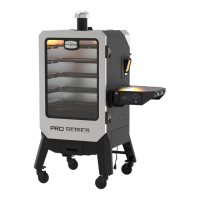® 12 ..
ENGLISH
HOT SMOKING
The form of cooking known as hot smoking refers to longer cooking
times and at lower temperatures (also known as low and slow), but
results in more natural flavor on your prepared foods. The band of
pink (after smoking) is referred to as a smoke ring and is highly prized
by outdoor chefs. Smoking foods with hardwood pellets will turn
light-colored meats and poultry pink, whereas it will add a band of
pink to darker cuts of meat.
For best results, allow time for meats to rest after cooking. This
allows the natural juices to migrate back into the meat fiber,
giving a much juicer, flavorful cut. Resting times can be as little
as 3 minutes and up to 60 minutes, depending on the size of
the protein.
Follow our guide of smoking different proteins. It is important to
note that it is not possible to tell if a meat cut is done by simply
looking at it. Using a meat probe or a Pit Boss® Meat Thermometer
is the best way to determine the internal temperature of the foods
you are cooking.
Helpful tips:
• Meat will close its fibers after it reaches an internal temperature
of 49ºC / 120ºF, so best to prepare for a smoking session with a
cold, or very cold, selection of foods before placing them inside
the smoker.
• Leave open space between the foods and the extremities of the
smoke cabinet for proper heat flow. Food on a crowded smoker
will require more cooking time. Use a set of long-handled tongs
for turning meats, and a spatula for softer items like fish and
cheese. Using a piercing utensil, such as a fork, will prick the
meat and allow the juices to escape.
• Fattier meats with lots of connective tissue are best in a smoker,
as the fats renders, delivering juicy smoked sensations.
• Start with a small pork shoulder roast, which is inexpensive and
more forgiving, then move on to larger cuts like brisket and ribs.
• Tenderloins and lean roasts require more attention, as the meat
dries out faster. Ensure that there is lots of fluid in the water pan
at all times during smoke sessions with less fatty meats. Liquids
such as fruit juice, cider vinegar, wine, or beer can offer a subtle
but flavorful impact to your meat cuts.
• If you are near the end of a smoking session, reduce the amount
of moisture in the smoking chamber by letting the water pan run
dry. This will allow the flavor components of your food to crisp
up and/or caramelize.
• Sugar-based sauces are best applied near the end of cooking to
prevent flare-ups.
MEAT TYPE
FINISHED
INTERNAL TEMP
POULTRY
Turkey (whole) 74°C / 165°F
Chicken (whole) 74°C / 165°F
Drumsticks, Breasts 74°C / 165°F
Small Game Birds 74°C / 165°F
Duck 74°C / 165°F
PORK
Ham (whole) 71°C / 160°F
Roast 74°C / 165°F
Tenderloin 82°C / 180°F
Spare Ribs 88°C / 190°F
Baby Back Ribs 88°C / 190°F
Butt (Shoulder) 90-98°C / 195-210°F
BEEF
Prime Rib 57°C / 135°F
Tenderloin 60°C / 140°F
Roast 63°C / 145°F
Spare Ribs 79°C / 175°F
Brisket 90-98°C / 195-210°F
WILD GAME
Tenderloin 74°C / 165°F
Roast 74°C / 165°F
SEAFOOD
Fillets 63°C / 145°F
Salmon (whole) 63°C / 145°F
Lobster 63°C / 145°F
Snapshot this page
for reference. You
can thank us later!
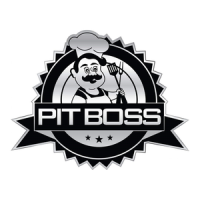
